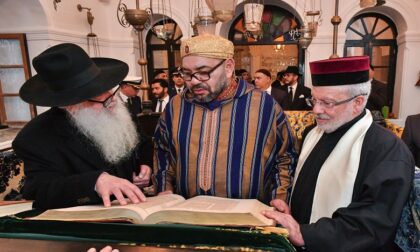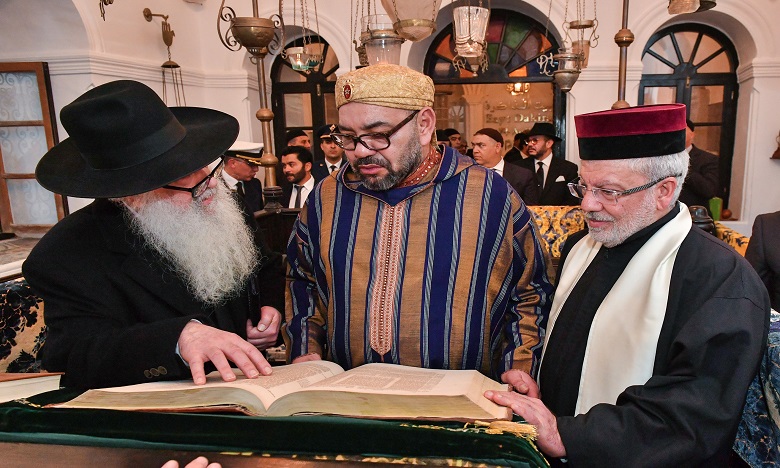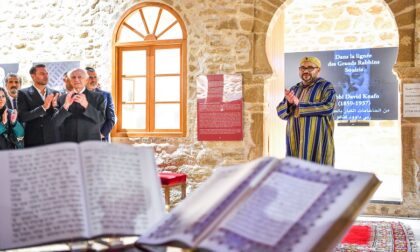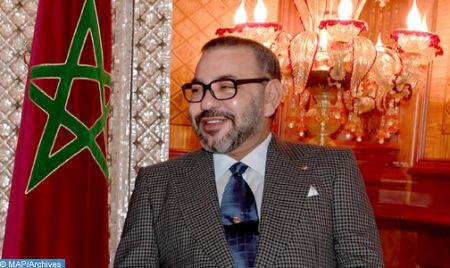 King Mohammed VI who started Wednesday a visit to the Atlantic city of Essaouira paid shortly after arrival a visit to ‘Bayt Dakira’, a spiritual space that tells the story and history of Judaism in Essaouira and in Morocco, a space that preserves and perpetuates the Judeo-Moroccan memory and heritage.
King Mohammed VI who started Wednesday a visit to the Atlantic city of Essaouira paid shortly after arrival a visit to ‘Bayt Dakira’, a spiritual space that tells the story and history of Judaism in Essaouira and in Morocco, a space that preserves and perpetuates the Judeo-Moroccan memory and heritage.
This historical, cultural and spiritual space hosts “Slat Attia” Synagogue; “Bayt Dakira” or the house of memory and history; and the Haim & Celia Zafrani International Research Center on the history of relations between Judaism and Islam.
The visit to this edifice reflects the special interest that King Mohammed VI, Commander of the Faithful, attaches to the cultural and religious heritage of the Moroccan Jewish community, and his unrelenting efforts to preserve the richness and diversity of the spiritual components of the Kingdom and its authentic heritage.
Upon his arrival at “Bayt Dakira”, the Monarch was greeted by Royal Advisor and president of the Essaouira-Mogador Association, André Azoulay, and by the members of the Scientific Committee of “Bayt Dakira” as well as by the board of the Essaouira-Mogador Association, initiator of this project, and the architects in charge of the edifice rehabilitation.
The Sovereign was then greeted by the Chief Rabbi of Casablanca, Joseph Israel, and Chief Rabbi David Pinto, before visiting the “Slat Attia” prayer hall, one of the most emblematic synagogues of Essaouira-Mogador which reflects the exceptional singularity and richness of Moroccan Judaism.
The Sovereign was also greeted by Audrey Azoulay, Director-General of the UNESCO.
During the visit, André Azoulay, who offered to the Monarch copies of The Koran and The Torah, delivered an address in which he affirmed that the Sovereign’s visit seals the rebirth of the city of Essaouira, which has always been turned towards the rest of the world. It is a historic day that bears the imprint of “our secular and millenary Morocco that has been able to protect the very great diversity, which is the central wealth of our country,” the president of the Essaouira-Mogador Association said.
“This house is the house of memory and history. It is also that of the Moroccan compass that the world needs today, a world in search of landmarks, a world that turns its back on all those values that are those of our country under the leadership of HM the King, Commander of the Faithful,” Azoulay added.
“Bayt Dakira” is a place of memory that tells through objects, texts, photos and films the exceptional saga of Judaism in the city of Essaouira and its heritage.
“Bayt Dakira”, which presents and explains all the passages of Jewish life in Essaouira, from birth to death and from Bar Mitzvah to marriage, is also a place of pedagogy thanks to the Haim and Celia Zafrani Research Center, which constitutes a space for exchange between researchers from different horizons and a platform for sharing, transmission and resistance to amnesia.
The visit was marked by religious songs performed by Cantor Michel Abittan and prayers by the Chief Rabbi of Casablanca, Joseph Israel.
At the end of the visit, the King was greeted by 27 personalities from the Moroccan Jewish community and the world.
Later in the evening, King Mohammed VI offered a dinner banquet in honor of members of the Moroccan Jewish community and other Moroccan and foreign personalities who were present during the sovereign’s visit to Bayt Dakira.




